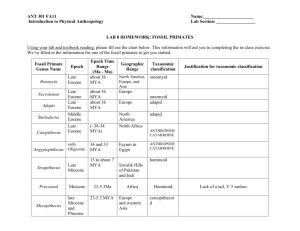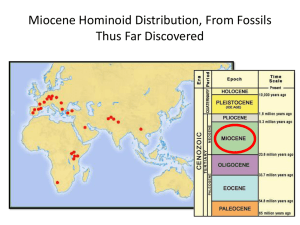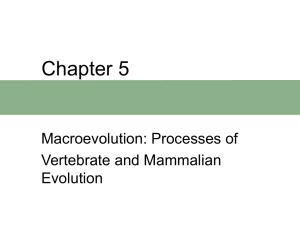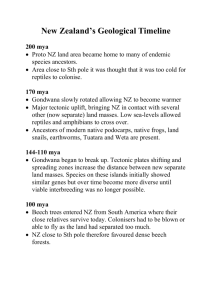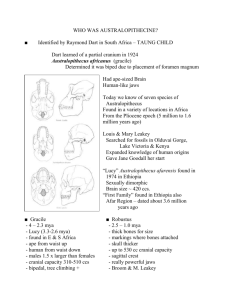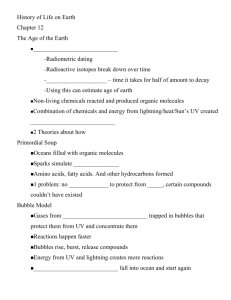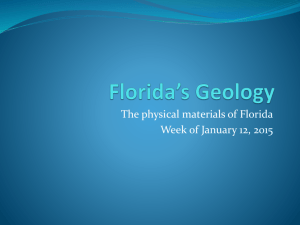Chapter 7 Mammalian/Primate Evolutionary History
advertisement
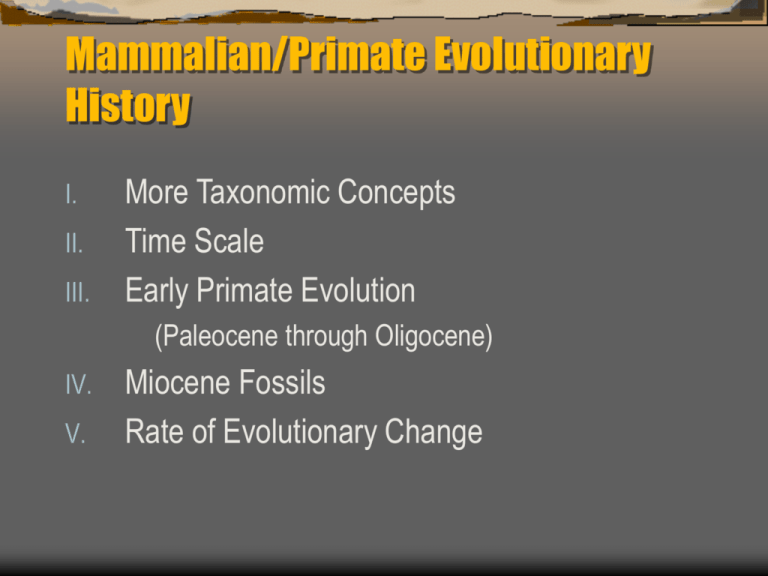
Mammalian/Primate Evolutionary History I. II. III. More Taxonomic Concepts Time Scale Early Primate Evolution (Paleocene through Oligocene) IV. V. Miocene Fossils Rate of Evolutionary Change I. Taxonomic Concepts A. Structures that are shared through descent from a common ancestor are called homologies. B. Homoplasy is the process by which similarities can develop in different groups of organisms. I. Taxonomic Concepts C. Structures in organisms that are used for the same function, but have developed independently and are not the result of common descent, are called analogies. D. Analogies are often the result of convergent evolution. I. Taxonomic Concepts E. Cladistic Taxonomy (Reminder) An approach to taxonomy that groups species according to shared derived characteristics. – Traits that reflecting the ancestral condition of an organism are primitive. – Traits shared by all members of a group, but not present before the group's appearance, are said to be shared derived characteristics. II. Time Scale: Geological Eras A. Paleozoic The first vertebrates appeared 500 mya B. Mesozoic Reptiles were dominant land vertebrates. Placental mammals appeared 70 mya C. Cenozoic Divided into two periods: Tertiary and Quaternary and 7 epochs. II. Time Scale: Cenozoic Epochs Draw and fill in this chart: Epoch Paleocene Eocene Oligocene Miocene Pliocene Pleistocene Holocene Time 65 mya 55 mya 34 mya 23 mya 5 mya 1.8 mya 0.01 mya Primates II. Time Scale: Mammalian Evolution The Cenozoic era is known as the Age of Mammals. After dinosaurs became extinct, mammals underwent adaptive radiation, resulting in rapid expansion and diversification. One advantage was the larger neocortex, which controls higher brain functions, comprised the majority of brain volume in mammals resulting in greater ability to learn. III. Early Primate Evolution Primate origins began in the placental mammal radiation 65 mya with the plesiadapiformes, represented by members of the genus Purgatorius. B. There are very scarce traces of the beginnings of the primate radiation. C. The earliest undoubted primates appear in the Eocene epoch. D. Most of our knowledge of primate Oligocene evolution comes from a site in Egypt, the Fayum. A. Eocene Forms Prosimians start here Omomyidae family is ancestral to tarsiers Adapidae family is ancestral to lemurs and lorises Oligocene Forms Possible roots of anthropoid evolution are illustrated by different Fayum (a region of Egypt) forms: Apidium – Small, primate, that may lie near or before the evolutionary divergence of Old and New World anthropoids. Aegyptopithecus – Largest of the Fayum primates with a small brain, large snout, and none of the traits of Old World monkeys or the hominoids. IV. Miocene Fossils A. Miocene was marked by a spectacular hominoid radiation and could be called “the golden age of hominoids” (apes). B. Hominoids are grouped geographically: African forms (23-14 mya), European forms (13-11 mya), and Asian forms (16-7 mya). C. Miocene hominoid fossils were geographically widespread, numerous, span between 23 and 6 mya and are poorly understood overall. IV. More Miocene D. Proconsul is an important early Miocene form Transitional between early anthropoids and later hominoids Mixture of ape and monkey traits – – – – Y-5 Molar No Tail Intermembral Index ~1.0 Palmigrade locomotion V. Rate of Evolution A. Punctuated Equilibrium – Long periods of no change punctuated by rapid evolution and speciation – S. Gould and N. Eldredge – Explains gaps in record B. Phyletic Gradualism Darwin’s idea of slow gradual change leading to eventual speciation
